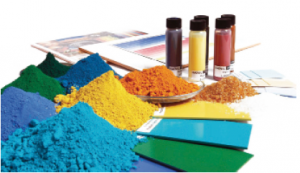Why Powder Coating
ECONOMIC CONSIDERATIONS

The excellence of the powder-coated finish is accompanied by substantial cost savings, when compared to liquid coating systems. Since powder contains no VOCs, air used to exhaust the powder spray booth can be recirculated directly to the plant, eliminating the cost of heating or cooling the makeup air. Ovens that cure solvent-based coatings must heat and exhaust huge volumes of air to ensure that the solvent fumes do not reach a potentially explosive level. With no solvent in powder coating, the exhaust required in the ovens is lower, resulting in energy and costsavings in spite of the higher curing temperatures that powder coating requires.
Labor and Efficiency Savings
There are savings in labor costs because less training is required to operate a powder coating system, and there is no mixing of powder with solvents or catalysts. Maintenance costs are also low, as most clean-ups can be done with a vacuum.
The powder application system can also bring greater operating efficiency to the finishing operation, which can save both time and money. Parts can be racked closer together on a conveyor, so more parts can pass through a production line in a given period of time, resulting in lower unit costs. More parts can also be coated automati- cally, as powder coating does not run, drip, or sag, resulting in significantly lower reject rates. And with appropriate application equipment,powder materials, and efficient recovery methods, one-coat application and overall powder utilization efficiency of 95% to 98% is readily achievable. If more than one color is required, color change can be accomplished in a relatively short period of time. And up to 99% of the powder sprayed at the product surface, but not adhering, can be recovered and reused, resulting in minimal waste disposal costs.
Today’s powder coatings offer a wide range of performance properties and glosses, and can match virtually any color or texture. Film thicknesses from under one mil (.03 mm) to over 15mil (.38 mm) are possible.
APPLICATIONS
Powder coatings are now used in hundreds of applications. As market potential grows, research devoted to product improvement also increases, leading to further innovations and market expansion.
Powder Coating Markets
One of the biggest potential powder coating users is the appliance industry. The high-quality finish is both attractive and durable, and a viable alternative for porcelain enamel and liquid finishes on traditional appliance surfaces. These include dryer drums, front and side panels of ranges and refrigerators, washer tops and lids, air conditioner cabinets, water heaters, dishwasher racks, and cavities of microwave ovens. Technological developments have resulted in powder coatings with lower gloss, lower temperature curing requirements, and stronger resistance to chips, scratches, detergents, and grease. All these features have led to the use of powder coatings on about 40% of all appliance finishes.
Powder is also used as a primer-surfacer on component parts for trucks and recreational vehicles. Clear powders, over a liquid base coat, are being developed for exterior auto body finishing. The architectural and building market uses powder coating on file cabinets, shelving, alumi- num extrusions for window frames, door frames, and modular office furniture. Posts, rails, fencing, metal gutters, highway and parking lot poles, guard rails, farm implements, garden tools and tractors, patio furniture, and other products used outdoors all benefit from the high weatherability factor of powder coating.
Countless everyday uses for powder coating include fire extinguishers, mechanical pencils and pens, thumbtacks,barbecue grills, and vending machines. Sporting goods equipment uses include bicycle frames, golf club shafts, ski poles, and exercise equipment.Technological advancements have allowed expansion of powder coating to nonmetal surfaces, such as ceramics, wood, plastic, and brass so that bottles, shower stalls, dashboards, and even toilet seats are now powder coated.
ENVIRONMENTAL IMPLICATIONS
With the current emphasis on control of emissions from industrial processes and overall concerns about air quality, ground water, and hazardous wastes, powder coatings offer an environmental advantage that may be a determining factor in selecting powder coating as a finishing process.
No solvents are involved ,in the mixing, application, or clean-up of a powder coating operation, virtually eliminating solvent emissions and the need for venting, filtering, or solvent recovery systems that would be required to control VOCs.This greatly simplifies the permitting process needed for installation, expansion, and operation of facilities, and makes compliance with federal and state regulations much easier. It also allows the possibility of including a finishing operation in a non-attainment area where other systems may not be permitted.
Most Powders Nonhazardous
In addition, the powders used for powder coatings are solids and most are classified as nonhazardous. Their use eliminates or minimizes problems and expenses associated with the disposal of hazardous wastes from a finishing process. There is no sludge, fouled spray booth filters, or solvent to contend with. Up to 99% of powder overspray can be recovered and reused, with automatic recycling units collecting the overspray powder and returning it directly to the feed hopper, where it returns to the system. In instances where there is waste, it can be handled as a non-water-soluble solid, presenting few disposal problems.
POWDER COATING GROWTH
Because of these and other advantages, powder coating system installations continue at a dramatic rate. Development work on materials, equipment, and new applications and surfaces will bring dynamic changes to the powder coating industry. Applications not possible a few years ago may become practical and advantageous in the near future. The potential powder user should work closely with suppliers to stay current on the latest developments in powder coating materials, application, maintenance, and clean-up. And with continually changing environmental regulations, it is best to check with local officials for disposal recommendations.

 D5 Creation
D5 Creation
Comments are Closed